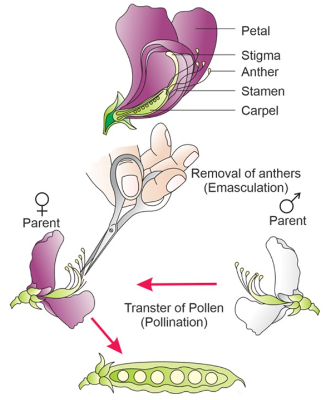Table of Contents
Crop improvement lies at the heart of global agriculture, and one of the key methods in this pursuit is artificial pollination. In this fascinating world of controlled plant breeding, precision is paramount. Ensuring that only the desired pollen grains are used for pollination while protecting the stigma from unwanted contamination is a delicate process achieved through emasculation and bagging techniques.
Artificial pollination, also known as assisted pollination or manual pollination, involves human intervention in the pollination process to ensure the transfer of pollen from the male reproductive parts (anthers) to the female reproductive parts (stigmas) of flowers. This method has gained prominence in agriculture as a means to safeguard food production and enhance crop yields.

Steps for Artificial Pollination
When it comes to crossing experiments, particularly in cases where we want to avoid accidental pollination from undesired sources, two fundamental techniques come into play: emasculation and bagging.
Emasculation
Emasculation, a critical step in the artificial hybridization process, is akin to a surgical procedure on a flower. If the female parent plant boasts bisexual flowers (containing both male and female reproductive parts), it’s imperative to prevent self-pollination or contamination. This is achieved by carefully removing the anthers from the flower bud before they release pollen. A delicate pair of forceps is the tool of choice for this delicate operation. The process of emasculation ensures that only the desired male pollen will be used for pollination.
Bagging
After the delicate process of emasculation, the next act is bagging. Emasculated flowers are shielded from the world by carefully covering them with a suitable bag, often made from butter paper. This protective layer ensures that the stigma of the emasculated flower remains pristine and untouched by any unwanted pollen that may be carried by the wind or curious insects. Bagging is a vital step in maintaining the purity of the pollination process.
Pollination and Rebagging
When the stigma of the bagged female flower is in the receptive phase, it’s time to introduce the chosen pollen. This pollen, collected from the anthers of the male parent plant, represents the genetic future of the crop. Delicately, these mature pollen grains are dusted onto the stigma of the female flower. This precise act of pollination ensures that only the desired genetic material is transferred.
Following this act of pollination, the flower is once again carefully bagged. This re-bagging serves as the final safeguard against any potential contamination or unintended pollination. Now, the fruits are allowed to develop, each one carrying the promise of the carefully selected genetic traits.
Skipping of emasculation in Unisexual Flowers
In cases where the female parent plant bears unisexual flowers (containing either male or female reproductive parts but not both), emasculation is not required. Instead, the process begins by bagging the female flower buds before they have a chance to open. When the stigma of the bagged flower becomes receptive, pollination is carried out using the desired pollen, and the flower is promptly rebagged to protect its genetic purity.
The outcome of Artificial Pollination
Artificial pollination offers several advantages:
- Increased Crop Yield: By controlling the pollination process, farmers can ensure a higher rate of successful fertilization, leading to increased crop yields.
- Crop Improvement: Artificial pollination allows for controlled crossbreeding, facilitating the development of new and improved plant varieties.
- Crop Protection: Isolating pollinated flowers helps protect crops from unwanted cross-pollination, ensuring the genetic purity of the crop.
- Pollinator Independence: Artificial pollination reduces reliance on natural pollinators, which is particularly beneficial when pollinator populations are declining.
Conclusion
Artificial pollination has become an essential tool in modern agriculture, enabling growers to overcome challenges posed by declining pollinator populations and optimize crop production. While it requires careful attention and expertise, the benefits in terms of increased yields and crop improvement are substantial. However, it is essential to strike a balance between artificial and natural pollination methods to maintain biodiversity and ecosystem health.
Frequently Asked Questions on Artificial Pollination
Why is artificial pollination necessary?
Artificial pollination is necessary to ensure consistent crop production in the face of declining natural pollinator populations and to achieve higher crop yields by controlling the pollination process.
What tools are used in artificial pollination?
Tools commonly used in artificial pollination include fine brushes, tweezers, collecting surfaces, and isolation bags or netting.
Can artificial pollination lead to genetic modification of plants?
While artificial pollination does not typically involve genetic modification, it can facilitate controlled crossbreeding to develop new plant varieties with desired traits.
is artificial pollination more efficient than natural pollination?
Artificial pollination can be more efficient in controlled environments, but it may not entirely replace the ecological benefits of natural pollination, which supports biodiversity and ecosystem health.
Are there any risks associated with artificial pollination?
One potential risk is the accidental transfer of undesirable traits or pathogens if not performed carefully. Additionally, overreliance on artificial pollination could disrupt natural ecosystems and pollinator populations.








